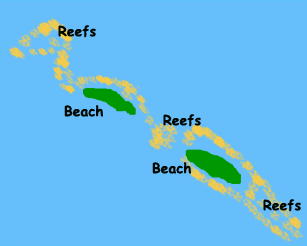

Zapatillas Cays are two beautiful islands on a coral platform that are surrounded by reefs. Zapatillas Keys are located inside the Bastimentos Island National Marine Park. The two islands are 34 and 14 hectares respectively.
They offer beautiful beaches, clear waters, coral reefs and small, shady forests.
The western island, Zapatillas Minor, is sometimes the base for scientists researching the marine turtle. The leatherback and the hawksbill turtles come to lay their eggs, in season, on these beaches.
On Zapatillas Major there is the Park Rangers refuge, the only habitation on the islands, as the islands are managed by the Government Agency for Protection of the Natural Resources.
Full day tours to Zapatilla Cays depart every day from Bocas. From Bocas del Toro, an hour-and-a-half boat ride through the Bastimentos National Marine Park takes you to Zapatilla Cays. You will usually have a stop at Coral Cay for lunch on the the return trip. There are open air restaurants there which are built on stilts with wooden walkways connecting the restaurant, kitchen and store that sells gasoline and canned goods.

Eight kilometers northeast of Crawl Cay is Zapatilla Cay, which is actually two small islands - Cayo Zapatilla Norte & Cayo Zapatilla Sur - there is some dispute as to why the name, but you can see that with some imagination the islands appear as small shoes, "zapatillas being the Spanish for "small shoes". Panama's National Environmental Authority (ANAM) manages the Cay. There is an ANAM center on the southeastern island, and visitors pay to land on the cays. Resisents of Panama pay substantially less than visitors from abroad. You are permitted to camp on the islands for a fee.
The best of Zapatillas's undersea world are the Coral Islands, about 300 metres offshore. There are beautiful coral formations in shallow waters, and they are very good for snorkelling. In the maximum depth of 20 feet of water, you can see angel fishes, groupers, snappers and colourful parrot and butterfly fishes. Lobsters, crabs, morey eels hide themselves in the cracks in the coral.
All of the beaches on the island are excellent for swimming, and there is a 45-minute nature trail that wends its way through mangrove swamp and other habitats on a rough trail.With some difficulty, you can complete the circuit through the center of the island and return along the leeward beach.
On the nature trail, you reach the garden of an old house with tropical fruit trees and a water hole (undrinklable water today) that is said to have been built by pirates and that there was buried buried treasure. The trail takes you to the windward beach, where driftwood blown in by the wind is heaped on the sand. On through a mangrove swamp marked by trail markers. Followed by a scrub forest with native plants. The trail emerges onto the leeward beach, and you progress through a large coconut plantation owned by the Ngöbe-Buglé Indians. The plantation has a small native house where the Ngöbe-Buglé stay when they come to harvest the coconut crop. And eventually you will end up back at the ANAM center further down the beach.
The other island can then be visited to see the bird rookeries where sea birds are in abundance and brown pelicans windsurf on the waves.